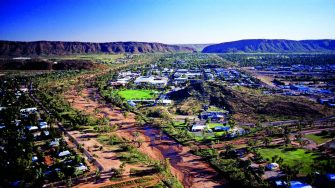
This project investigates the characteristics of the local climate in the CBD area of Alice Springs, NT. It identifies hot spots in the city to develop and evaluate appropriate local climate mitigation scenarios such as cool materials, urban shading devices, water-based technologies, greenery and tree planting.
Project Aim (and/or Objectives)
One of the most documented climate phenomena is the urban heat island (UHI) effect, namely the local overheating in the built environment, with higher ambient temperatures than in the adjacent surroundings. This is documented for hundreds of cities around the world including major cities in Australia and it adds to and interacts with global climate change. The inner area of the CBD of Alice Springs, a remote town in Australia’s Northern Territory, is affected by local overheating and the urban heat island effect adds to the already high temperatures in the area, which impacts thermal comfort, energy consumption and health, with serious consequences on the local economy. The specific objective of this project is decreasing the ambient temperature in Alice Springs by identifying hot spots in the city, developing and evaluating appropriate local climate mitigation scenarios (five mitigation scenarios involving UHI mitigation strategies such as use of reflective materials for buildings and pavements, street shading, windbreak and evaporative systems), and propose optimum solutions. Advanced simulation techniques have been used to quantitatively evaluate their UHI mitigation impact.
The following activities have been carried out:
- Experimental campaign involving aerial infrared monitoring using drone technologies and terrestrial monitoring of meteorological parameters to investigate the climate response features of the built environment.
- Identification of the hot spots in the city and development of appropriate mitigation scenarios.
- Climatic evaluation of the developed mitigation scenarios compared to the existing situation in Alice Springs, using advanced simulation techniques and proposal for the optimum mitigation solution to be implemented.
Project outcomes
The results have shown that:
- The proposed mitigation technologies can decrease the maximum ambient temperature from 42.3 °C to 41.1°C (close to 1.2°C)
- The minimum ambient temperature in the area can decrease from 35.0 °C to 24.7°C (close to 10.3 °C)
- The combined use of reflective materials, shading, windbreak and water-based system to improve the microclimate of urban areas is the most effective mitigation strategy
- It has been shown that the maximum local temperature reduction achieved in the area with combined scenario is approximately 15.9 °C for the wind speed of 4m/s and directions from south-east.
Project participants
Project leader: Scientia Prof. Mattheos Santamouris
Research team: Dr Riccardo Paolini, Dr Afroditi Synnefa, Dr Shamila Haddad, Dr Giulia Ulpiani
Contact person
Prof. Mattheos Santamouris m.santamouris@unsw.edu.au
